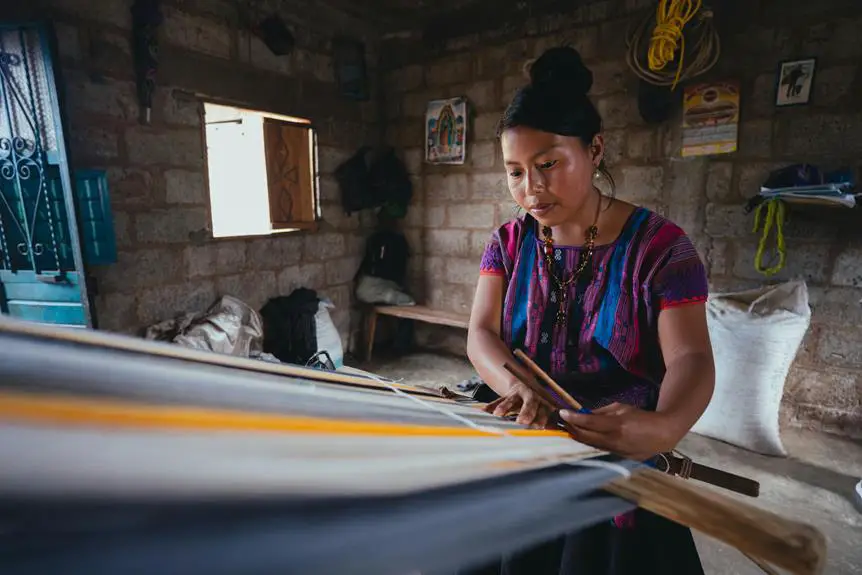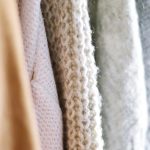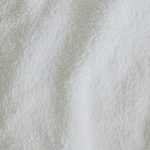When you're looking to embroider on knit fabrics, you'll find it's not as straightforward as on woven materials. You need to consider the unique stretch and movement of knits, which can present challenges if you're not prepared. Choosing the right fabric and tools is essential, but that's just the beginning. Understanding how to handle the stitches and maintain the fabric's integrity can make all the difference in your final piece. So, what techniques can you implement to achieve a smooth, professional finish?
Table of Contents
Key Takeaways
- Choose knits with stretch and a smooth surface, like cotton jersey, for optimal embroidery results.
- Use ballpoint needles and maintain loose tension to prevent puckering and protect fabric fibers.
- Stabilize your fabric with appropriate cut-away or tear-away stabilizers to maintain shape during stitching.
- Pre-wash and properly dry your fabric to avoid distortion and ensure a clean, smooth surface for embroidery.
Choosing the Right Fabric
When you're choosing fabric for embroidery, opt for knits that have a bit of stretch and a smooth surface to ensure the best results. Fabrics like cotton jersey or interlock are excellent choices because they allow your needle to glide smoothly, reducing the risk of snagging. Look for knits with a tight weave, as they hold the embroidery stitches better and provide a neater finish.
Avoid fabrics that are too thin or slippery, as they can lead to misaligned designs and puckering. Instead, consider medium-weight knits that maintain their shape while being flexible enough to work with. If you're new to embroidering on knits, it's wise to test your chosen fabric with a few sample stitches before committing to your project.
Also, pay attention to the fabric's color and pattern, as these can affect the visibility of your embroidery. Solid colors typically provide a clean backdrop, while busy patterns might distract from your design.
Essential Tools and Supplies
To achieve the best results in embroidering on knit fabrics, you'll need the right tools and supplies to make the process smoother and more efficient.
Start with a quality embroidery machine or a good set of embroidery needles specifically designed for knits, as these will help prevent snagging. You'll also want to stock up on a variety of embroidery threads, preferably polyester or rayon, which hold up well on stretchy fabrics.
Don't forget about stabilizers; a cut-away or tear-away stabilizer will provide the necessary support for your design. This will help maintain the knit's integrity while you stitch. A pair of sharp scissors will come in handy for trimming threads and any excess stabilizer.
You'll also need fabric clips or pins to secure your knit fabric without causing damage. A ruler or measuring tape ensures your designs are perfectly placed, while a fabric marking pen allows you to outline where you want to stitch.
Preparing Your Knit Fabric
Start by pre-washing your knit fabric to remove any sizing or chemicals that could interfere with the embroidery process. This step ensures your fabric is clean and ready for embroidery. Use a gentle detergent and wash it in cold water to prevent any shrinking or distortion. After washing, dry your fabric according to its care instructions, either air-drying or using a low heat setting.
Next, iron your fabric if necessary, but be careful with the heat settings. Use a pressing cloth to protect the knit and avoid damaging the fibers. When the fabric is smooth and wrinkle-free, lay it flat on your work surface.
Before you start embroidering, consider stabilizing your knit fabric. A good stabilizer can prevent stretching and distortion during the embroidery process. Cut a piece of stabilizer slightly larger than your design area and apply it to the back of your fabric. You can use temporary adhesive spray to hold it in place.
Selecting Suitable Embroidery Techniques
Choosing the right embroidery techniques can enhance the look of your knit fabric while ensuring the design holds up well over time. When selecting techniques, consider the stretch and texture of your knit material. For instance, use designs that allow for flexibility, like satin stitches or small motifs, to prevent distortion.
You might also want to explore using stabilizers. These provide support during the stitching process, helping to maintain the fabric's shape. Tear-away stabilizers can be excellent for lightweight knits, while cut-away options work well for heavier fabrics.
Next, think about the type of needle and thread you'll use. A ballpoint needle is ideal for knits, as it won't snag the fibers. Pair it with a thread that has a slight stretch, like polyester, to complement the knit's elasticity.
Tips for Stitching on Knits
When stitching on knits, make sure to keep your tension loose to avoid puckering and ensure a smooth finish. Knits have a natural stretch, so being too tight can distort your design.
Use a ballpoint needle, as it's designed to slide between the fibers rather than cutting through them, which helps prevent snags.
Select a stabilizer that suits your project. A tear-away stabilizer often works well for lightweight knits, while a cut-away stabilizer is ideal for heavier fabrics. This support will keep your stitches even and reduce any stretching during the embroidery process.
Always test your design on a scrap piece of the same fabric before starting on your main project. This way, you can adjust your settings, stitch types, or stabilizers as needed.
Keep your embroidery speed moderate; going too fast can lead to uneven stitches. If you're using a machine, a slower pace allows the fabric to move smoothly under the needle.
Lastly, consider using a hoop that's specifically designed for knits. This helps maintain your fabric's alignment without causing excessive tension.
With these tips, you'll find that stitching on knits can be both enjoyable and rewarding!
Caring for Embroidered Knit Items
Caring for your embroidered knit items ensures they remain vibrant and intact for years to come. Start by washing them gently. Use cold water and a mild detergent to prevent fading and preserve the fabric's elasticity. Turn your items inside out before washing to protect the embroidery from friction.
When it's time to dry, avoid using a dryer. Instead, lay your knit items flat on a clean towel to air dry. This method helps maintain their shape and prevents any potential damage from heat. If you need to iron your items, do so carefully. Use a low heat setting and place a cloth between the iron and the embroidery to avoid scorching.
For storage, keep your embroidered knits in a cool, dry place, avoiding direct sunlight to prevent color fading. If you notice any loose threads after washing, trim them carefully instead of pulling, which could unravel your design.
Following these simple care tips will help your embroidered knit items look fresh and beautiful for years to come, allowing you to enjoy your handiwork without worry.
Frequently Asked Questions
Can I Use Regular Embroidery Thread on Knit Fabrics?
You can use regular embroidery thread on knit fabrics, but it might not stretch well. Consider using a polyester or specialty thread designed for stretchy materials to ensure your design maintains its integrity and flexibility.
How Do I Avoid Puckering While Embroidering on Knits?
To avoid puckering while embroidering on knits, use a stabilizer, select the right needle, and adjust your tension. Also, keep your stitches loose and choose a design that complements the fabric's stretch.
What Types of Needles Work Best for Knit Embroidery?
When choosing needles for knit embroidery, use ballpoint or jersey needles. They're designed to slide between the fibers without damaging them, ensuring your stitches lay flat and your fabric maintains its stretch.
Can I Machine Wash Embroidered Knit Items Without Damage?
Yes, you can machine wash embroidered knit items, but it's best to use a gentle cycle and cold water. Avoid harsh detergents and air dry them to maintain the embroidery's appearance and prevent damage.
How Do I Stabilize Very Stretchy Knit Fabrics for Embroidery?
To stabilize very stretchy knit fabrics for embroidery, you can use tear-away or cut-away stabilizers. These provide support without distorting the fabric, ensuring your stitches stay neat and secure while you work on your project.
- A Look Into the World of Quadrille’s China Seas Fabrics - June 20, 2025
- What to Know About Sheet Metal and Fabrication in China - June 20, 2025
- The Unique Properties of Silk Crepe De Chine Fabric - June 20, 2025





